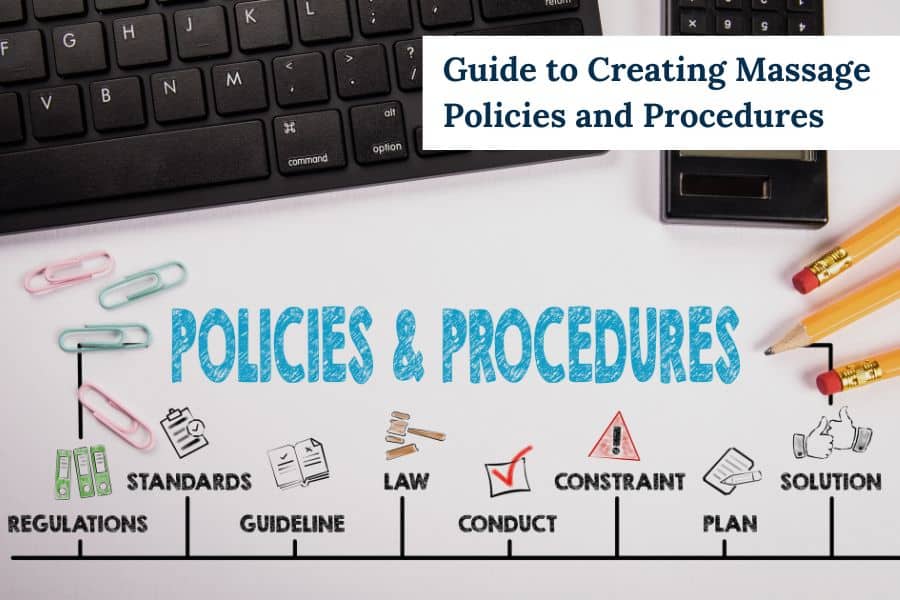

Why does a massage therapy practice need to create policies and procedures? Simply put, written policies and procedures set the stage for an efficient and effective business. Plus, they help you stay on the right side of the law, and ensure your clients have a consistent and positive experience. Whether you’re flying solo, running a small team of therapists, or overseeing a large massage franchise, getting your policies and procedures right can be a game-changer for your massage therapy business.
What are massage policies and procedures? Massage therapy policies are the rules or guidelines that define what’s expected in different situations, like how to handle cancellations or late clients, or what level of hygiene and sanitation is required. Procedures, on the other hand, lay out the exact steps to perform specific tasks, such as setting up the massage room or the new client intake process.
In this blog post, you’ll learn why policies and procedures are important for every massage practice, what kinds of policies you need to make, and how to put them into action. We’ll even throw in some practical examples (downloadable PDF), tips on writing policies and procedures, and common mistakes to avoid. By the end, you’ll be equipped to write or revise your own policies and procedures, setting your massage business up for long-term success.
So, why exactly do you need well-crafted policies and procedures in your massage therapy business? First, let’s clarify these terms a bit more:
Policy: A policy is a set of rules or guidelines that outline what is expected in certain situations. It sets the stage for what should be done, and serves as a guiding principle that helps in decision-making. Think of it as the “what” and “why.”
Procedure: A procedure is a specific set of actions or steps to be followed in order to accomplish a task or implement a policy. It’s the “how-to” for executing the rules set by the policy.
For example, a massage business might have a policy stating that all therapists must sanitize their hands and equipment between sessions to maintain hygiene and sanitation. The procedure would then spell out exactly how the sanitization should be carried out, including what products to use and the steps for proper cleaning.
One big reason to have these in place is legal protection. Let’s face it, nobody wants to be in a courtroom explaining why their client didn’t get the service they expected. Clear, written policies can be your best defense in certain legal disputes and misunderstandings. For instance, a well-defined cancellation policy can save you headaches and potentially safeguard you against client claims.
Having solid procedures in place isn’t just for show; it’s also about keeping your business running efficiently. Imagine the time you’ll save during training when you can hand a new employee a manual outlining each task step by step. This speeds up decision-making and streamlines everything from client bookings to wrapping up sessions. Moreover, clients appreciate knowing what to expect when they walk through your door. This creates consistent quality and service, which is a win for client experience.
So, by taking the time to draft sound policies and procedures for you massage practice, you’re actually investing in the backbone of your business: legal safety, operational efficiency, and top-tier client satisfaction. And it’s an investment that will pay off no matter the size of your massage practice.
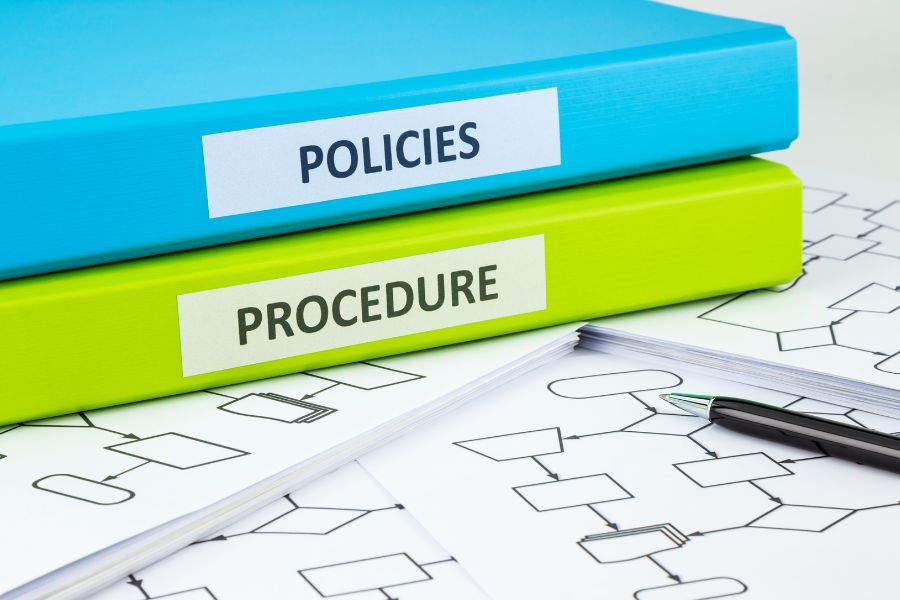
In this section, we’ll cover the essential massage policies, offering guidance to help you create practical and useful rules for your massage business. Whether you’re just starting out or looking to streamline an existing practice, this guide can serve as a helpful policy checklist. But understand that you don’t have to use every single policy on the list—especially if you’re a solo practitioner without any employees or co-workers. Pick and choose the ones that fit your business best.
This policy sets the standard for how therapists and staff should behave. It outlines professional boundaries, how to manage client relationships, and the way to resolve conflicts. It helps maintain an atmosphere of professionalism and mutual respect between clients and staff.
Your go-to guide for all things scheduling. It should specify how far in advance appointments need to be booked and what the cancellation window is, usually 24-48 hours. If a client cancels late or doesn’t show up at all, the policy should outline the fees they’ll incur. This ensures that therapists are fairly compensated for their time. All successful massage businesses such as Massage Envy and Hand and Stone have a clear cancellation policy, and your practice should have one too.
Before you even lay hands on a client, you need them to have completed a thorough intake process. A client intake policy should require clients to complete a detailed health history questionnaire (medical background), informed consent, and review of other relevant policies prior to their first appointment. Key information to collect would be any chronic conditions, allergies, or medications that could affect treatment. It’s a proactive way to plan effective and safe therapy sessions.
If a client is running late, what happens? Spell it out here—whether you’ll cut their session short or reschedule for another time. Make sure to let them know if they’ll be charged for the full session even if they’re late.
No one likes a no-show, especially when you’ve blocked out time for a client. Use this policy to let them know what happens if they ghost an appointment. Will they have to pay a fee? Will they need to pre-pay for future appointments? Large massage franchises such as Massage Heights, MassageLuXe, and Elements Massage have clear client no-show policies, and small solo or group practices should also have one.
Before initiating any treatment, it’s imperative to obtain informed consent from the client. Clearly outline the techniques you plan to use, the level of pressure to be applied, and any other pertinent treatment details. Secure the client’s explicit approval before proceeding. It’s crucial to inform the client that they have the autonomy to express any discomfort, request adjustments during the session, or stop the session. Proper informed consent not only adheres to ethical standards but also fosters a trusting relationship between therapist and client.
Client confidentiality and trust is a cornerstone for building and sustaining a reputable massage therapy practice and building rapport with clients. This policy serves as a guide to reassure clients that all their personal details, medical history, and even casual conversations during sessions will be kept safe and secure. It’s essential to specify how you’re protecting this sensitive data, whether it’s locked away in filing cabinets or encrypted in a secure digital format. A failure to uphold confidentiality not only damages your business reputation but could also lead to legal consequences. Take the necessary steps to make sure your confidentiality policy is robust, transparent, and consistently applied across your practice. For massage business owners, it’s an ethical obligation to have a strong confidentiality and data privacy policy.
Having a thorough documentation policy can help with tracking the individual needs and preferences of each client by ensuring the accurate and timely completion of documentation. This policy should specify what needs to be documented—such as pressure preferences, allergies, and focus areas—and what types of documents should be used, such as SOAP notes and client assessment forms. With a robust documentation policy, you not only make each session more personalized but also protect your business by maintaining an accurate and detailed account of client interactions. This is essential for quality control, legal protection, and fostering client trust.
Establishing a clear hygiene and sanitation policy is a must. This policy should outline specific cleanliness standards, such as the frequency of washing linens, the types of cleaning products used, and the protocols for sanitizing equipment and treatment rooms. The aim is to assure both clients and therapists that their health and safety are prioritized.
In the massage business, client comfort and modesty are top priorities. Your draping policy should clarify the methods used to keep clients covered during a session. Consider discussing the type of linens or towels used, how they’re arranged to respect client privacy, and that only the areas currently being treated will be undraped. Make sure mention that therapists are trained to manage draping in a professional manner, alleviating any client concerns upfront.
Behavior goes both ways, and clients also need some guidelines. Specify acceptable and unacceptable conduct during the session, such as conversation boundaries and physical interaction limits. Make it clear that failure to adhere to this policy could result in immediate session termination and potentially being banned from future bookings.
Sometimes sessions need to be cut short or even canceled, and not just from the client’s end. This policy should outline scenarios where a therapist may need to stop a session early. For example, inappropriate behavior from a client. Be explicit about warning signs and how they’re communicated, ensuring that both staff and clients know the rules of engagement. Note that in certain circumstances, the client may still be charged the full price for the session.
Knowing what you offer sets the stage for client expectations. This policy should list out all the types of massage and related services you provide, from Swedish to deep tissue. Explain any prep or post-care requirements for specific treatments. This not only helps clients pick what suits them but also streamlines your booking process.
It’s about looking professional and keeping things hygienic. Lay down what’s okay and not okay for therapists to wear while on duty. Are jeans too casual? Are there requirements for footwear? This policy ensures that every team member presents a consistent, professional image to clients.
When it comes to money matters, clear rules save everyone headaches. Your Payment Policy should spell out when payments are due (before of after the session), what payment methods are accepted, and any penalties for late payments. Make it crystal clear if upfront payments are required and if you offer any discounts or package deals. Setting these guidelines helps avoid awkward conversations down the line and ensures you get paid for your skills and time.
Your reward system can make clients feel valued, but it can also get messy if not clearly defined. Specify how points are earned and redeemed, any expiration dates, and what happens to unused points if a client stops coming. Outline the buying and redemption process for gift cards as well. Having this all written down clears up any ambiguities and protects your bottom line.
This one’s for keeping your service top-notch. State your minimum requirements for new hires, such as certain certifications or hours of hands-on experience. Also, note how often team members need to take continued education courses. Be specific about who covers the costs of this training; is it the business or the employee?
Nobody wants to give money back, but sometimes it’s necessary. State the conditions under which a client can request a refund or a service credit. For instance, if a client is dissatisfied with a massage, do they get a do-over with a different therapist? Or do they get their money back? This keeps disgruntled clients from trashing you on social media because they’ll know what they’re entitled to.
With the internet’s influence, how you show up online is important. This policy should guide your staff on how to interact (or not interact) with clients on social media platforms. Are they allowed to accept friend requests from clients or respond to reviews? Lay down the rules for maintaining a professional online demeanor and outline the appropriate way to respond to both positive and negative reviews.
Health is a two-way street in the massage therapy business. Clearly outline when a therapist should call in sick instead of coming to work. Same goes for clients. Set a policy for how much notice a client must give if they are too ill to attend their appointment, and outline the measures taken to sanitize the area if someone shows up sick.
Each policy should be tailored to the unique needs and culture of your massage practice. And of course, once drafted, it’s smart to get them reviewed by a legal advisor.
The following are a few basic examples of policies for a massage therapy business. Feel free to use these as a template to guide and inspire you in making policies for your massage practice. In most cases, it is best to create detailed and customized policies that specifically fit the unique needs of your massage business. We strongly recommend consulting with a legal expert or industry professionals to make sure your policies are up-to-date and compliant with current laws and standards.
(Click on the images below to view and/or download the policy examples as a PDF.)


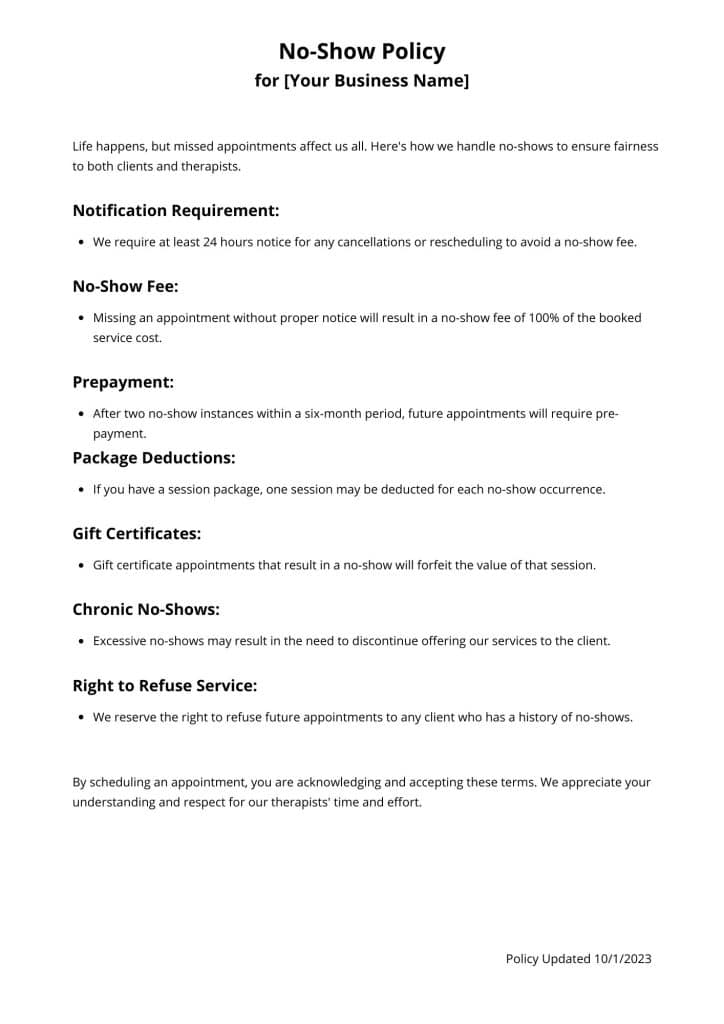
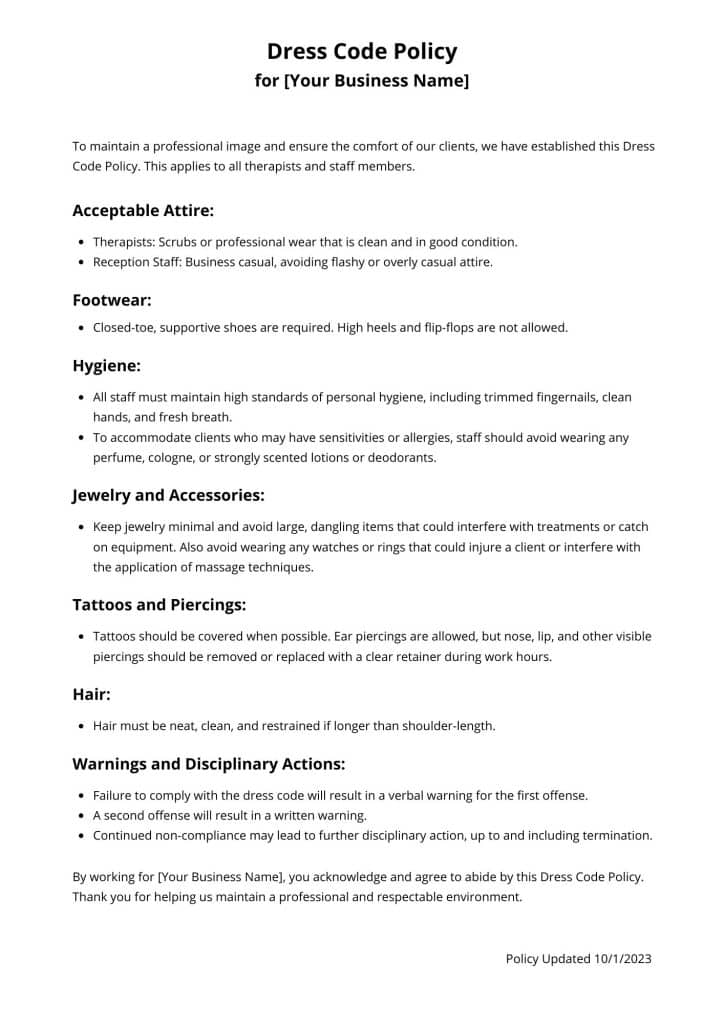

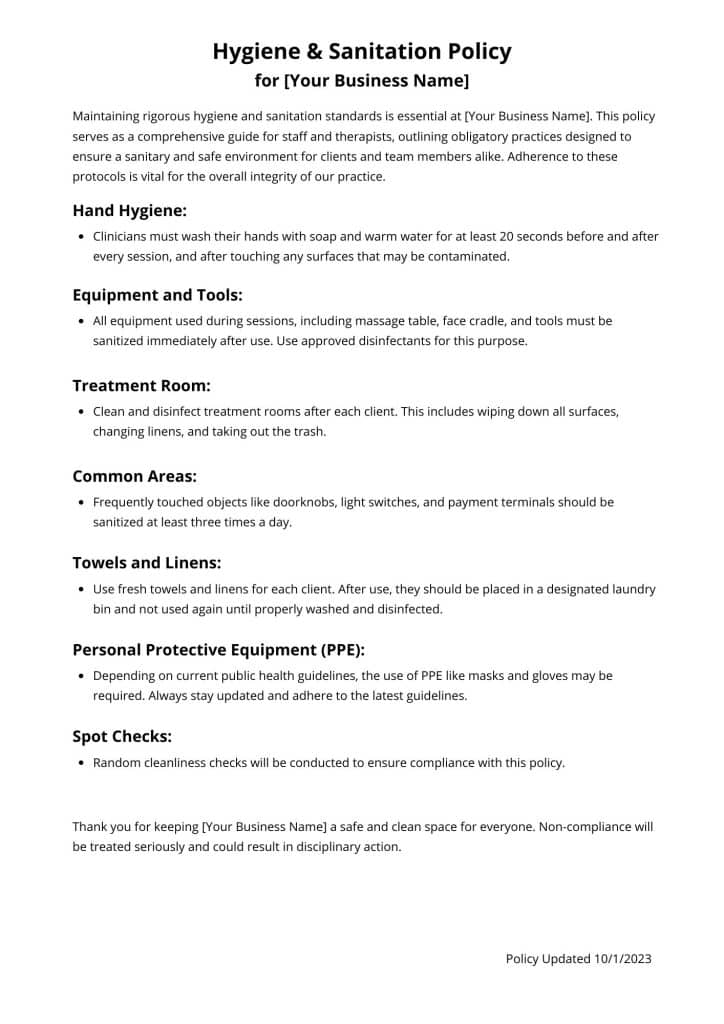
Alright, you’ve got your policies in check, so what’s next? Procedures—the action plans that power your policies. If policies are the rules, think of procedures as the playbook. These step-by-step guides help you and your team carry out your massage business operations with precision, from greeting a client to managing a conflict.
Why are detailed procedures important? Because they erase the guesswork. With clear procedures, you set the stage for consistent, high-quality service. For example, a client intake procedure could start with a warm welcome, move on to discussing the client’s health history, and finish with outlining the planned massage treatment.
You don’t need to reinvent the wheel. Start by listing daily tasks and outlining them in an easy-to-follow manner. Document everything, like how to set up a massage room, how to handle a complaint, or even how to process payments. Over time, these procedures will become second nature to your team, allowing you to focus on growing your practice. And they will help keep everyone on the same page.
When running a massage business, having a range of clear and well-defined procedures is key to smooth and efficient operations. From greeting new clients and assisting them with the intake process, to sanitation procedures and client follow-up processes, a well-structured approach can elevate the customer experience and make your life easier. In this section, we’ll go over the main types of procedures you should think about setting up in your massage therapy practice. *Note: It is important that your procedures align with your policies.
First impressions matter. Create a smooth, step-by-step intake process that starts with a warm greeting and then moves to collecting essential data. This includes the client’s health history, contraindications for massage, an explanation of massage options, and obtaining informed consent. Digital massage forms can make this quicker but always offer a paper option for those less tech-savvy.
From the moment a client walks in, the experience should be seamless. Designate a front-desk workflow that ensures prompt greetings. Include directions to waiting areas and a system to notify therapists of client arrivals. A simple notification via an internal chat system can work wonders here.
Keep it simple but effective. Whether clients prefer to book by phone, online, or in person, make sure your team follows the same booking steps. This should cover the basics like availability checks, calendar management, and appointment confirmation. If you’re using massage booking software, make sure everyone knows how to operate it.
Don’t underestimate the impact of a well-prepared space. Your procedure should cover everything from cleaning and sanitizing the room to setting up towels, oils, and any required equipment like a table warmer or hot stone warmer, essential oil diffuser, and adjusting the massage table height so that the client can easily get on the table. A clean and welcoming room elevates the client’s comfort and trust in your service.
Before laying a finger on your client, a brief but thorough client assessment is essential. This is where therapists can understand specific client needs, pain points, and preferences for this session. Document these details of this discussion along with any findings from assessment techniques for reference in future sessions. You could use consultation forms or a digital record-keeping system for this.
Kick things off on the right note. Your therapists should have a checklist of topics to cover with clients before starting the session. This can include confirming the type of massage they will be receiving, the pressure level they’re comfortable with, and any other specific concerns they may have.
In the middle of a session, communication remains key. This procedure should spell out how therapists should check in on comfort levels, make adjustments based on client feedback, and manage the session time wisely. Timing markers can be useful for ensuring each massage phase gets its due attention.
The way you wrap up a session can make all the difference in client satisfaction. Include steps for therapists to discuss observations and recommendations with the client. This is also a good time to suggest follow-up appointments or specific exercises to help with their issue.
To make the end of the appointment as smooth as possible, have a set procedure for check-out and payment. This includes how you handle different payment methods and how you will gather client feedback, whether it’s through a paper card or a quick digital survey. And don’t miss the opportunity to book their next appointment. Right after the payment, either the therapist or the receptionist should ask about scheduling the next session.
Don’t let the client relationship end when they walk out the door. Outline a procedure for post-appointment communication. This can include sending a thank-you email, any aftercare tips related to their treatment, and a prompt to book their next session. Consider setting up an automated system for this to ensure consistent follow-up and marketing. This keeps the lines of communication open and can also increase the chances of them becoming a repeat client.
Knowing when you’re low on essential supplies avoids last-minute stress. This procedure guides how to track items like oils, towels, and retail products. Specify how often the inventory should be checked and who’s responsible, as well as the lead time required for reordering.
Excellent cleaning and sanitation is non-negotiable in any massage practice. Create daily and weekly checklists that specify what needs cleaning and when. This includes massage equipment like tables and tools, employee break room, bathroom, reception area and other common areas, and even the parking area. Make it clear who’s responsible for each task and what to do in case cleaning supplies run low.
Onboarding sets the tone for a productive and cohesive massage work environment. Outline the essential steps for training new hires. This should include an introduction to your practice’s culture, a walkthrough of the massage therapy procedures, instruction of proprietary treatments, and a review of all essential policies. It could also include ongoing employee requirements like maintaining an active massage license and having current massage liability insurance.
Even the best massage practices receive complaints now and then. Have a structured approach for resolving them. Whether the issue is service quality or something else, make sure you have a script or specific guidelines to handle it professionally. Consistency is key to maintaining trust.
Cancellations can mess up your schedule and affect revenue. Establish steps for how to manage last-minute cancellations or no-shows. This can include a documentation process and any penalties. Make sure your team knows how to handle these situations, including any follow-up needed to reschedule or address concerns.
Emergencies are stressful, but having a clear plan can make all the difference. Your policy should detail what steps to take if a medical or other emergency occurs, including who to call and how to provide first aid. Keep a quick-reference guide handy for both staff and clients.
Money matters, so keep your bookkeeping and financial records in check. Establish a regular timeline for tracking income, expenses, and other financial key points. Whether you’re using software or spreadsheets, everyone involved should know how and when to update and review these metrics.
Don’t risk losing vital information. Have a robust procedure for backing up digital and physical client records. Decide how often backups should occur and who is responsible for this. Maintain strict security measures to ensure privacy and compliance with legal standards.
A thriving team is good for business. Schedule periodic performance reviews and make sure you know how to deliver constructive feedback. The process should be clear on when and how promotions or role changes can occur, keeping the team motivated and aligned with your business goals.
And there we have it—essential procedures to keep your massage therapy practice running smoothly.
It’s a good idea to get your massage therapy procedures down on paper. The procedure below is an example of what a simple written client intake procedure looks like. This should give you some ideas of how to format and detail your own procedures, making your day-to-day operations more efficient and your team more cohesive.
Objective: To ensure a smooth, professional, and welcoming experience for all new clients from the moment they walk through the door. This procedure will guide you through the necessary steps for client intake, ensuring we collect essential health history, discuss service options, and obtain informed consent.
Tools Required:
Note: This procedure is to be followed for all new clients without exception. For returning clients, ensure that their previous records are up-to-date, especially their Health History Form.
By following these steps, you help ensure that each client gets the attention and care they need while maintaining the integrity and professionalism of our practice.
So you’ve gotten a pretty good rundown of essential policies and procedures for a massage therapy business. Knowing is half the battle, but now comes the actual work: putting these guidelines into practice. The goal here is straightforward—transform your knowledge into action, ensuring your massage practice runs like a well-oiled machine (pun intended).
Whether you’re setting client expectations, managing your schedule, or even dealing with the rare difficult client situation, the key is consistency. Stick to your policies, train your staff well, and don’t cut corners. After all, successful implementation of your policies is just as crucial as having them in the first place.
This list should give you a good starting point for setting up the nuts and bolts of your massage therapy practice.
If you’re setting up or revamping the policies and procedures for your massage practice, that’s great; it’s essential for smooth operations. However, errors in this department can be costly, both in time and reputation. Here are some pitfalls you’ll want to avoid:
So there you have it. Avoiding these common mistakes can make your policies and procedures a strong backbone for your massage business, rather than a weak link. Good policies make for a smooth-running, professional operation.
Alright, we’ve covered a lot of ground here, from essential policies every massage practice should have, to the common mistakes to steer clear of. Setting up and maintaining solid, well-thought-out policies and procedures isn’t just about compliance or ticking off boxes; it’s about building a foundation that allows your massage business to operate effectively and provide excellent client experiences.
Make sure you’re listening to your clients, training your staff, and staying current on the best ways to manage both the business and clinical sides of your practice. Remember, solid policies don’t make a business rigid; they make it resilient. Start implementing these best practices today to give your business the structure it needs to thrive.
Email is often a good method for reaching out to your clients about policy changes. Update your clients a couple of weeks before the new policy kicks in, and make sure to lay out the changes in a clear and straightforward manner. Use bullet points or headings for easy skimming. It’s also good practice to have a printed copy of the new policies at your reception desk for walk-in clients and a policy section on your website.
There’s no one-size-fits-all answer here, but a good rule of thumb is to review your policies at least once a year. New legislation, changes in the industry best practices, or shifts in your business model can all make an update necessary. Set a yearly reminder to sit down and review everything from client intake forms to employee onboarding manuals.
Be transparent about fees for missed appointments and the timeframe in which a client can cancel without penalty. Make it clear how far in advance you require cancellations; 24-48 hours is standard. Specify the consequences of repeated no-shows, such as pre-payment for future appointments. Make sure this policy is visible during the booking process and included in appointment confirmation emails.
Communication is key. Make sure your late policy is laid out clearly in your appointment confirmations and on your website. If a client is late, a simple but firm verbal reminder at checkout can go a long way. Always offer the client the option to reschedule if they’ll miss out on their full session time due to being late.
Create a step-by-step guide for your staff on how to handle complaints, whether they’re about the massage itself or about billing. Take every complaint seriously and log it for review. Make sure to specify which types of complaints need to be escalated to a manager. Also, outline any compensation or refund policies you have for unsatisfactory service.
Plan for medical emergencies like allergic reactions or fainting, and outline what steps staff should follow in these cases. Identify who is responsible for calling emergency services and where first-aid kits are located. Don’t forget non-medical emergencies like power outages or fire; specify exit routes and meeting points. Keep a quick-reference guide in each therapy room and make emergency training part of your employee onboarding process.

Our complete MBLEx Prep Course is designed to provide you with a step-by-step comprehensive review of all areas of the massage licensing exam.